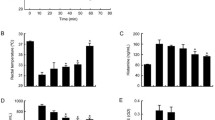Abstract
The ability of azelastine to inhibit IgE-mediated allergic histamine release from the peritoneal mast cells of actively sensitized rats was investigated and compared with selected antiallergic agents. Azelastine added simultaneously with the allergic stimuli (ovalbumin, OA, 10 μg/ml + phosphatidylserine, PS, 10 μg/ml) or preincubated with cells for 10 min prior to antigen challenge produced similar concentration-dependent inhibition of allergic histamine release. The IC50s (μM) following 10-min preincubation were as follows: azelastine = 4.8; astemizole = 86.3; ketotifen = 112.2; diphenhydramine = 133 and theophylline = 2040.3. At IC50 level azelastine was about 18, 23, 28 and 425 times as effective as astemizole, ketotifen (newer histamine H1-receptor antagonists), diphenhydramine (a traditional H1-receptor antagonist), and theophylline (a phosphodiesterase inhibitor), respectively. Sodium cromoglycate in a concentration range or 1–1000 μM (0 or 10-min preincubation) failed to exert any inhibitory effect. These data showed that among six drugs tested azelastine is the most potent inhibitor of allergic histamine release from rat peritoneal mast cells.
Similar content being viewed by others
References
H.J. Zechel, N. Brock, D. Lenke andU. Achterrath-Tuckermann,Pharmacological and toxicological properties of azelastine, a novel antiallergic agent, Arzneimittel-Forsch.31, 1184–1193 (1981).
S. Katayama, N. Imoto, H. Shionoya, T. Morimoto andY. Katah,Antiallergic effect of azelastine hydrochloride on immediate type hypersensitivity reactions in vivo and in vitro, Arzneimittel-Forsch.31, 1196–1203 (1981).
W. Diamantis, N. Chand, J.E. Harrison, S.M. Rooney andR.D. Sofia,Inhibition of IgE-mediated passive cutaneous anaphylaxis (PCA) by azelastine in rat, J. Allergy & Clin. Immunol.73, 184 (1984).
J. Perhach, J. Connell, L. Hamilton, L. Diamond, J. Weiler andJ. Melvin,Multicenter trial of azelastine in allergic rhinitis, J. Allergy & Clin. Immunol.73, 144 (1984).
W. Diamantis, N. Chand, J.E. Harrison, S.M. Rooney andR.D. Sofia,Dissociation of antiallergic (anti-PCA) activity from the antihistaminic and anti-serotonin activities of azelastine, Pharmacologist26, 251 (1984).
N. Chand, W. Diamantis andR.D. Sofia,Antagonism of leukotrienes, calcium and histamine by azelastine, Pharmacologist26, 252 (1984).
W. Diamantis, N. Chand, J.E. Harrison, J. Pillar, J.L. Perhach, Jr. andR.D. Sofia,Inhibition of release of SRS-A and its antagonism by azelastine (A), an H 1 antagonist-antiallergic agent, Pharmacologist24, 200 (1982).
N. Chand, K. Nolan, W. Diamantis, J.L. Perhach, Jr. andR.D. Sofia,Inhibition of leukotriene (SRS-A)-mediated allergic bronchospasm by azelastine, a novel, orally effective antiasthmatic drug, J. Allergy & Clin. Immunol.71, 149 (1983).
B. Fisher andW. Schmutzler,Inhibition by azelastine of the immunologically-induced histamine release from isolated guinea pig mast cells, Arzneimittel-Forsch.31, 1193–1195 (1981).
N. Chand, J. Pillar, W. Diamantis, J.L. Perhach, Jr. andSofia,Inhibition of calcium ionophore (A23187)-induced histamine release by a novel anti-allergic agent, 4-(p-chlorobenzyl)-2-(hexahydro-1-methyl-1H-azepine-4yl)-1(2H)-phthalazinone hydrochloride (azelastine; A5610), Int. J. Immunopharmacol.4, 342 (1982).
D.A.S. Fields, J. Pillar, W. Diamantis, J.L. Perhach, Jr. andR.D. Sofia,Inhibition by azelastine of nonallergic histamine release from rat peritoneal mast cells, J. Allergy & Clin. Immunol.73, 400–403 (1984).
N. Chand, J. Pillar, W. Diamantis, J.L. Perhach Jr. andR.D. Sofia,Inhibition of calcium ionophore (A23187)-stimulated histamine release from rat peritoneal mast cells by azelastine: Implications for its mode of action, Eur. J. Pharmac.96, 227–233 (1983).
I. Mota,The mechanism of anaphylaxis. I. Production and biological properties of ‘mast cell sensitizing’ antibody, Immunology7, 681–699 (1964).
P.A. Shore, A. Burkhalter andV.H. Cohn,A method for the fluorometric assay of histamine in tissues, J. Pharmac. exp. Ther.127, 182–196 (1959).
L.M. Lichtenstein andA.G. Osler,Studies on the mechanisms of hypersensitivity phenomena. IX. Histamine release from leukocytes by ragweed pollen antigen, J. exp. Med.120, 507–530 (1964).
J.C. Foreman,The pharmacological control of immediate hypersensitivity, Ann. Rev. Pharmacol. Tox.21, 63–81 (1981).
Author information
Authors and Affiliations
Rights and permissions
About this article
Cite this article
Chand, N., Pillar, J., Diamantis, W. et al. Inhibition of IgE-mediated allergic histamine release from rat peritoneal mast cells by azelastine and selected antiallergic drugs. Agents and Actions 16, 318–322 (1985). https://doi.org/10.1007/BF01982866
Received:
Issue Date:
DOI: https://doi.org/10.1007/BF01982866




